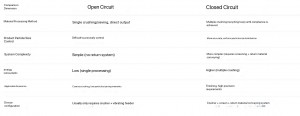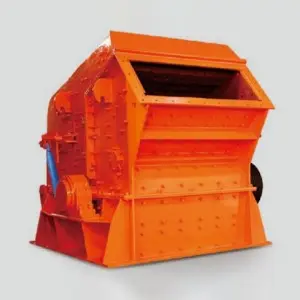In industries such as mining, construction, and recycling, the configuration of crushing and screening equipment directly affects production efficiency, energy consumption, and the quality of the final product. Among them, Open Circuit and Closed Circuit are two core process flows. Different configuration methods determine the material processing method, cycle load and the particle size distribution of the final product.
For equipment procurement and process design, understanding the operation principles, applicable scenarios and optimization strategies of these two systems is the key to ensuring the efficient operation of the crushing and screening system. This article will delve into the differences between open circuits and closed loops, their respective advantages, how to select the best configuration, and how to enhance overall efficiency through reasonable selection of crusher parts.
—
First, Open Circuit vs. Closed Loop: Basic Concepts and Operation Modes
1. Open Circuit
In an open circuit system, materials are directly discharged after one crushing or screening process without undergoing recycling and return material treatment. Its characteristics are:
• Single processing: The material passes through the crusher or screening machine only once. The unrefined part directly enters the next process or is used as the final product.
• No return material circulation: Materials not accepted by the target particle size will not be returned to the crusher for re-crushing, so the system structure is simple, but the control of product particle size is relatively difficult.
It is suitable for coarse crushing or scenarios with low requirements for particle size, such as primary crushing and pretreatment of building materials raw materials.
Typical applications
• Primary crushing in mines (such as coarse crushing by jaw crushers)
Preliminary treatment of construction waste
• Processing of materials without high-precision requirements
2. Closed Circuit
In a closed-loop circulation system, after the material is crushed or screened, the part that does not reach the target particle size will be returned to the crusher for reprocessing until it meets the requirements before being output. Its characteristics are:
• Recycled materials: The screening machine returns the materials that do not meet the particle size requirements (either too coarse or too large particles) to the crusher for re-crushing.
• Precise control of product particle size: By adjusting the return material volume, it can be ensured that the particle size distribution of the final product is more uniform and better meets the requirements.
• Higher energy consumption and more complex systems: Due to the addition of return material conveying and secondary crushing, the system consumes more energy, but the quality of the finished products is better.
Typical applications
• Fine crushing of ores (such as cone crushers, closed-circuit production of sand making machines)
High-precision production of sand and gravel aggregates (such as aggregates for concrete and asphalt)
• Recycling industry (such as fine crushing and screening of waste metals and plastics)
Second, the core differences between open circuits and closed loops
Key conclusion:
Open circuits are suitable for rough processing, such as primary crushing in mines. The system is simple and the cost is low, but the particle size of the product fluctuates greatly.
Closed-loop circulation is suitable for refined production, such as the processing of construction aggregates and recycled materials, ensuring that the final products meet strict particle size requirements. However, it requires more complex equipment and higher energy consumption.
Third, how to choose the best configuration? Analysis of Key Factors
When choosing between an open circuit and a closed loop, the following factors need to be comprehensively considered:
The particle size requirements of the final product
If the particle size requirements are loose (such as coarse aggregates, primary crushing), the open circuit is efficient and economical enough.
If strict control of particle size is required (such as 0-5mm fine sand, recovered metal powder), closed-loop circulation is a necessary choice.
2. Production scale and capacity demand
Large-scale coarse crushing (such as primary crushing in mines) usually adopts open circuits to maximize throughput.
High-capacity fine crushing (such as in sand making plants) is often combined with closed-loop circulation to ensure stable output.
3. Energy costs and operating budgets
Closed-loop circulation consumes more energy, but it can reduce waste and increase the yield of finished products.
Open circuits have low energy consumption, but they may require additional manual screening or secondary processing.
4. Compatibility of equipment configuration with the parts of the crusher
Closed-loop circulation requires more efficient screening machines (such as vibrating screens and drum screens) and reliable return material conveying systems (such as belt conveyors and chutes).
The selection of crushers (such as cone crushers and impact crushers) should match the hardness of the recycled material to ensure long-term stable operation.
Fourth, key strategies for optimizing the efficiency of crushing and screening
Whether an open circuit or a closed loop is chosen, reasonable selection of crusher parts and system optimization can further enhance efficiency.
The efficiency of the screening machine affects the closed-loop circulation effect
High-frequency vibrating screens can separate qualified and unqualified particles more quickly, reducing the amount of return materials.
The multi-layer screen design can simultaneously grade materials of different particle sizes, improving the overall output efficiency.
2. The stability of the return material system
The design of the return material conveyor belt or chute should avoid blockage to ensure smooth return of the circulating materials to the crusher.
The adaptability of the feeding port of the crusher should be matched with the amount of return materials to prevent overload or idling.
3. Wear resistance and maintenance of crusher parts
The high cycle load in a closed-loop circulation will accelerate the wear of parts such as the crushing chamber and liners. Therefore, highly wear-resistant materials (such as manganese steel and ceramic coatings) should be selected.
Regularly check the crushing gap (such as the adjustment of the discharge port of the cone crusher) to ensure stable crushing effect.
—
Fifth, Conclusion: How to configure the optimal crushing and screening system based on requirements?
Open circuits and closed-loop cycles each have their applicable scenarios. There is no absolute “optimal solution”, but rather a comprehensive balance needs to be made based on factors such as product requirements, production capacity demands, and energy costs.
• Pursuing simplicity, low cost and rough processing? Open circuits are a more efficient choice.
Need high-precision, stable particle size and fine products? Closed-loop circulation can ensure the best quality.
Ultimately, the rational selection of crusher parts, the optimization of the screening system and the management of returned materials are the core to achieving efficient crushing and screening. Through scientific configuration, enterprises can maximize production efficiency, reduce operating costs, and ensure that the final products meet market demands.
Post time: Nov-06-2025



